One-Pot Strategies for Lithium Recovery from Beta-Spodumene and LTA-Type Zeolite Synthesis
Abstract
1. Introduction
2. Materials and Methods
2.1. Raw Materials
2.2. Lithium Extraction and Obtaining LTA-Type Zeolite Procedure
2.3. Evaluation of Zeolite Adsorptive Properties
2.3.1. Cation-Exchange Capacity (CEC)
2.3.2. Density Functional Theory (DFT)
2.4. Characterisations
3. Results and Discussion
3.1. Recovery of Lithium as Li2CO3 and By-Product Formation of LTA-Type Zeolite
3.2. Cation-Exchange Capacity (CEC) Test
3.3. DFT Study of x/Al3+ Substitution in LPM-15 (x = Na+, NH4+ or Ca2+)
4. Conclusions
5. Patents
Supplementary Materials
Author Contributions
Funding
Data Availability Statement
Acknowledgments
Conflicts of Interest
Appendix A
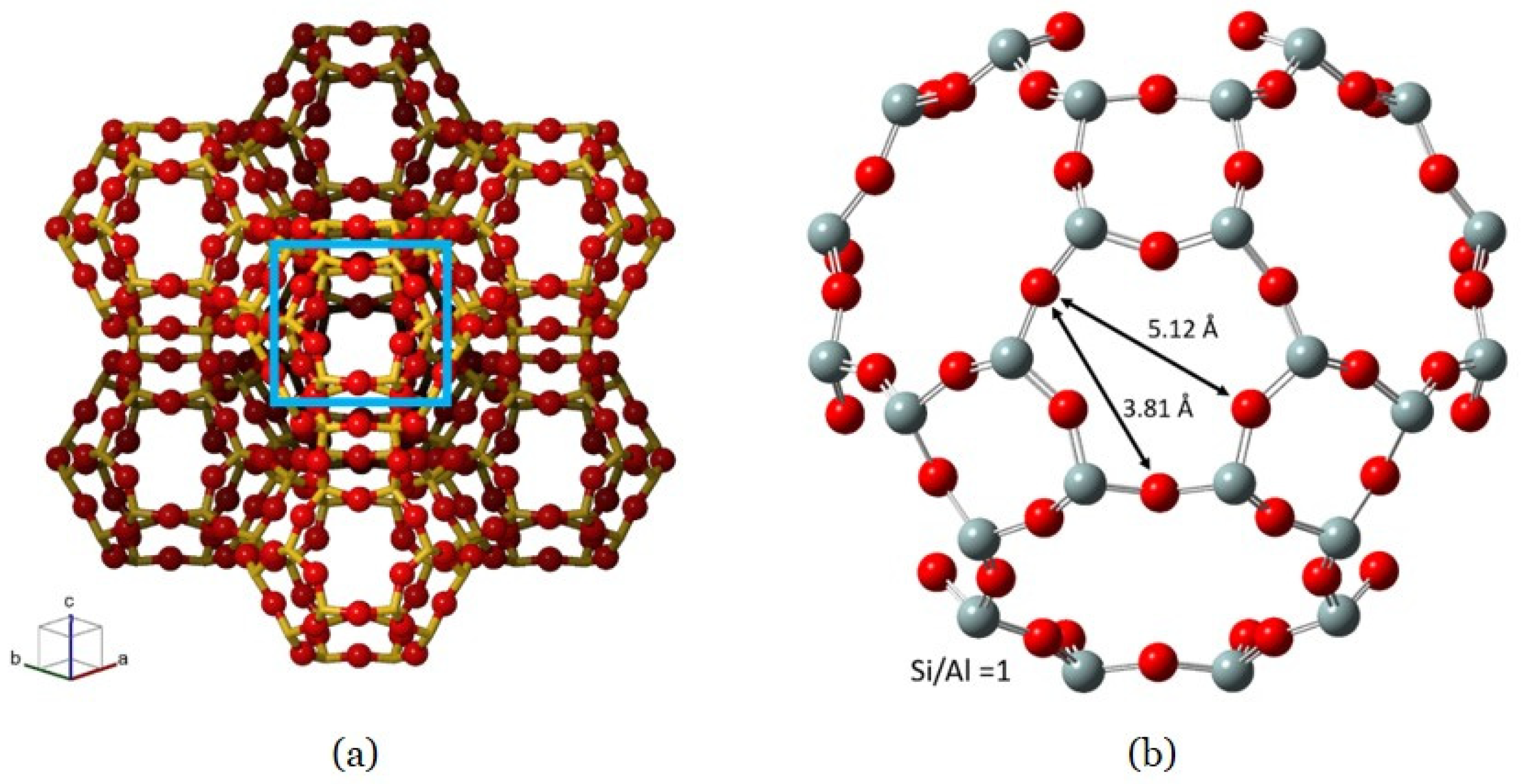

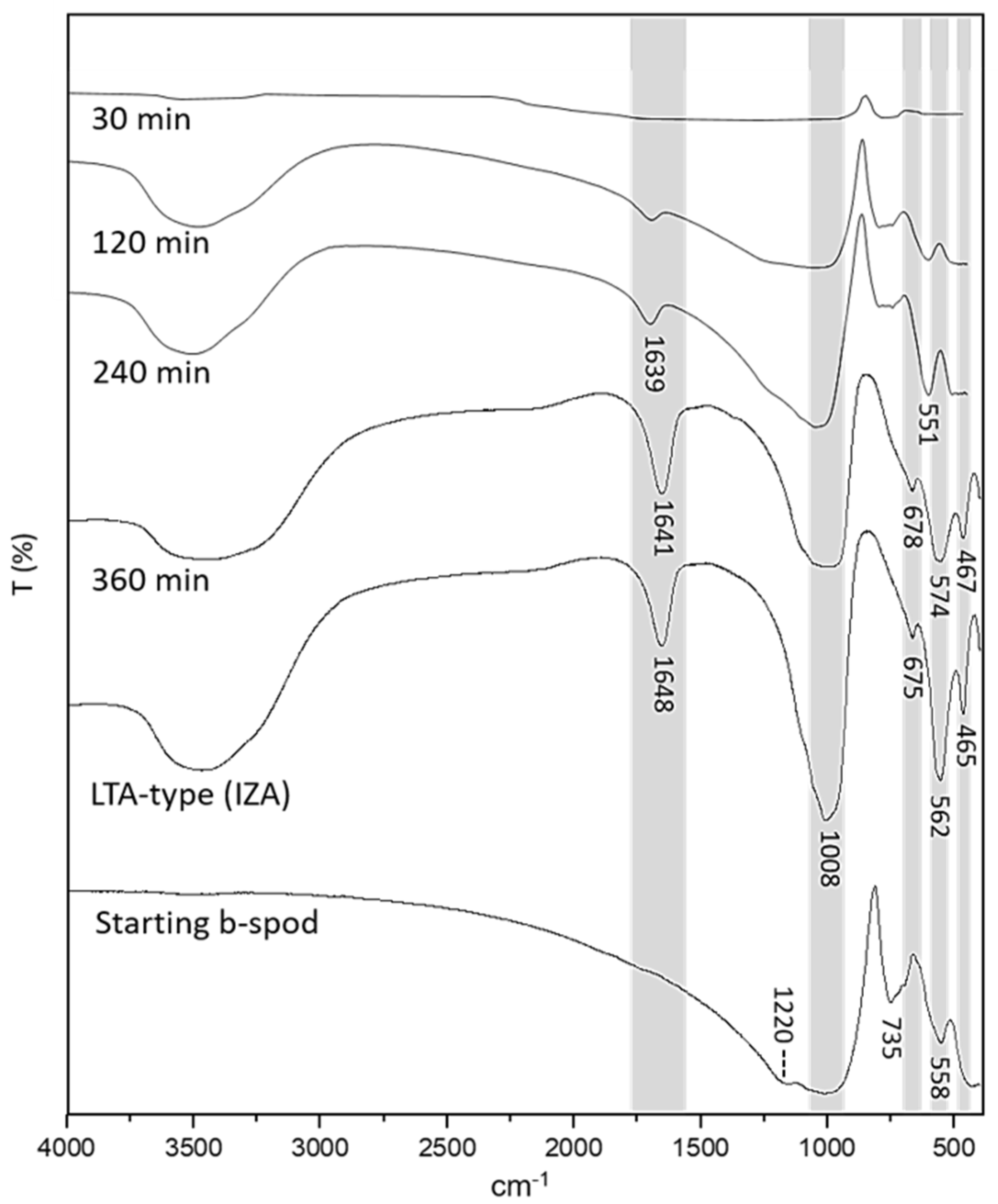
Appendix B
| Temperature (K) | 373 | 353 | 333 | 323 | 298 |
| Solubility | 0.72 | 0.85 | 1.01 | 1.08 | 1.27 |
| Reference | 360 min | 240 min | 120 min | 30 min |
| LTA zeolite (IZA) | 0.89 | 0.76 | 0.56 | 0.44 |
| Wavenumber (cm−1) | Denotation |
|---|---|
| 1008 | Asymmetric stretching vibrations of bridge bonds—νs Si-O(Si) and νs Si-O(Al). |
| 675 | Symmetric stretching of bridge bonds—νs Si-O-Si and νs Si-O-Al. |
| 562 | Symmetric stretching of Si-O-Si bonds and bending vibrations—δ O-Si-O. |
| 465 | Bending vibrations—δ O-Si-O in “antiphase”, and δ O-Al-O. |
| x/Al3+ | RPCS 1 | LP 2 | APV 3 | POD 4 | E 5 | ΔE 6 |
|---|---|---|---|---|---|---|
| x = Na+ | Center | 10.7 | 688.6 | 5.5 | <0.01 | 77.5 |
| Edge | 12.8 | 695.1 | 6.0 | 0.04 | 101.2 | |
| x = N | Center | 11.9 | 3338.7 | 10.7 | <0.01 | 106.1 |
| Edge | 11.7 | 2338.7 | 9.8 | 0.25 | 307.3 | |
| x = Ca2+ | Center | 11.9 | 876.2 | 5.8 | <0.01 | 115.4 |
| Edge | 12.0 | 863.3 | 5.9 | 0.14 | 188.5 |
References
- Martin, G.; Rentsch, L.; Höck, M.; Bertau, M. Lithium market research–global supply, future demand and price development. Energy Storage Mater. 2017, 6, 171–179. [Google Scholar] [CrossRef]
- Liu, Y.; Ma, B.; Lü, Y.; Wang, C.; Chen, Y. A review of lithium extraction from natural resources. Int. J. Miner. Metall. Mater. 2023, 30, 209–224. [Google Scholar] [CrossRef]
- Yelatontsev, D.; Mukhachev, A. Processing of lithium ores: Industrial technologies and case studies—A review. Hydrometallurgy 2021, 201, 105578. [Google Scholar] [CrossRef]
- Sarker, S.K.; Haque, N.; Bhuiyan, M.; Bruckard, W.; Pramanik, B.K. Recovery of strategically important critical minerals from mine tailings. J. Environ. Chem. Eng. 2022, 10, 107622. [Google Scholar] [CrossRef]
- Choubey, P.K.; Kim, M.S.; Srivastava, R.R.; Lee, J.C.; Lee, J.Y. Advance review on the exploitation of the prominent energy-storage element: Lithium. Part I: From mineral and brine resources. Miner. Eng. 2016, 89, 119–137. [Google Scholar] [CrossRef]
- Fleming, M.; Kannan, S.G.; Eggert, R. Long-run availability of mineral resources: The dynamic case of lithium. Resour. Policy 2024, 97, 105226. [Google Scholar] [CrossRef]
- Kanagasundaram, T.; Murphy, O.; Haji, M.N.; Wilson, J.J. The recovery and separation of lithium by using solvent extraction methods. Coord. Chem. Rev. 2024, 509, 215727. [Google Scholar] [CrossRef]
- Chen, J.; Zhang, M.; Wang, S. Research progress of synthesis methods for crystalline porous materials. Acta Chim. Sin. 2023, 81, 146. [Google Scholar] [CrossRef]
- Ibsaine, F.; Dionne, J.; Tran, L.H.; Coudert, L.; Pasquier, L.C.; Blais, J.F. Scaling up, mass balance and techno-economic study of a hydrothermal process used to synthesize zeolite from aluminosilicate residues obtained from lithium production. Miner. Eng. 2024, 216, 108841. [Google Scholar] [CrossRef]
- Mallette, A.J.; Shilpa, K.; Rimer, J.D. The current understanding of mechanistic pathways in zeolite crystallization. Chem. Rev. 2024, 124, 3416–3493. [Google Scholar] [CrossRef]
- Pérez-Botella, E.; Valencia, S.; Rey, F. Zeolites in adsorption processes: State of the art and future prospects. Chem. Rev. 2022, 122, 17647–17695. [Google Scholar] [CrossRef] [PubMed]
- da Silva, A.; Elias, E.B.C.D.; Cruz, T.J.T.; Pinto, F.G.H.S.; de Mello, M.I.; Bieseki, L.; Pergher, S.B.C. Synthesis and cation exchange of LTA zeolites synthesized from different silicon sources applied in CO2 adsorption. Coatings 2024, 14, 680. [Google Scholar] [CrossRef]
- Ibsaine, F.; Dionne, J.; Tran, L.H.; Coudert, L.; Pasquier, L.C.; Blais, J.F. Application of aluminosilicate residue-based zeolite from lithium extraction in water treatment. Micropor. Mesopor. Mater. 2025, 381, 113370. [Google Scholar] [CrossRef]
- Xing, P.; Wang, C.; Zeng, L.; Ma, B.; Wang, L.; Chen, Y.; Yang, C. Lithium extraction and hydroxysodalite zeolite synthesis by hydrothermal conversion of α-spodumene. ACS Sustain. Chem. Eng. 2019, 7, 9498–9505. [Google Scholar] [CrossRef]
- Xu, J.; Wei, X.; Han, J.; Qin, W. Synthesis and optimisation mechanism of functionalised adsorption materials for lithium-ion extraction: A review. Sep. Purif. Technol. 2024, 339, 126237. [Google Scholar] [CrossRef]
- dos Santos, L.L.; do Nascimento, R.M.; Pergher, S.B.C. Beta-spodumene: Na2CO3: NaCl system calcination: A kinetic study of the conversion to lithium salt. Chem. Eng. Res. Des. 2019, 147, 338–345. [Google Scholar] [CrossRef]
- Li, G.; Pidko, E.A. The nature and catalytic function of cation sites in zeolites: A computational perspective. ChemCatChem 2019, 11, 134–156. [Google Scholar] [CrossRef]
- Conroy, B.; Nayak, R.; Hidalgo, A.L.R.; Millar, G.J. Evaluation and application of machine learning principles to Zeolite LTA synthesis. Micropor. Mesopor. Mater. 2022, 335, 111802. [Google Scholar] [CrossRef]
- Salakjani, N.K.; Singh, P.; Nikoloski, A.N. Production of lithium–A literature review part 1: Pretreatment of spodumene. Min. Proc. Ext. Met. Rev. 2020, 41, 335–348. [Google Scholar] [CrossRef]
- dos Santos, L.L.; do Nascimento, R.M.; Pergher, S.B.C. Processo para Obtenção dos materiais LPM-15, LPM-16 e LPM-17, com Topologias Zeolíticas LTA, FAU e MOR, Respectivamente, como Subproduto da Extração do Lítio a partir do Beta-Espodumênio. Patent BR102018016312-4 B1, 20 February 2024. [Google Scholar]
- Cardoso, A.M.; Horn, M.B.; Ferret, L.S.; Azevedo, C.M.; Pires, M. Integrated synthesis of zeolites 4A and Na–P1 using coal fly ash for application in the formulation of detergents and swine wastewater treatment. J. Hazard. Mater. 2015, 287, 69–77. [Google Scholar] [CrossRef] [PubMed]
- Chen, J. A Density Functional Theory Study of the Structure and Chemistry of Zeolite Linde Type A (LTA). Ph.D. Thesis, Worcester Polytechnic Institute, Worcester, MA, USA, 2017; 146p. [Google Scholar]
- Antúnez-García, J.; Galván, D.H.; Petranovskii, V.; Murrieta-Rico, F.N.; Yocupicio-Gaxiola, R.I.; Shelyapina, M.G.; Fuentes-Moyado, S. The effect of chemical composition on the properties of LTA zeolite: A theoretical study. Comput. Mater. Sci. 2021, 196, 110557. [Google Scholar] [CrossRef]
- Astala, R.; Auerbach, S.M.; Monson, P.A. Density functional theory study of silica zeolite structures: Stabilities and mechanical properties of SOD, LTA, CHA, MOR, and MFI. J. Phys. Chem. B 2004, 108, 9208–9215. [Google Scholar] [CrossRef]
- Wolffis, J.J. Improved Partial Charge Models in Siliceous Zeolites for the Simulation of Adsorption and Identification of Catalytic Sites. Master’s Thesis, University of Nevada, Las Vegas, NV, USA, 2017; 112p. [Google Scholar]
- Abdullah, A.A.; Oskierski, H.C.; Altarawneh, M.; Senanayake, G.; Lumpkin, G.; Dlugogorski, B.Z. Phase transformation mechanism of spodumene during its calcination. Miner. Eng. 2019, 140, 105883. [Google Scholar] [CrossRef]
- Jandová, J.; Dvořák, P.; Vu, H.N. Processing of zinnwaldite waste to obtain Li2CO3. Hydrometallurgy 2010, 103, 12–18. [Google Scholar] [CrossRef]
- Li, S.; Li, J.; Dong, M.; Fan, S.; Zhao, T.; Wang, J.; Fan, W. Strategies to control zeolite particle morphology. Chem. Soc. Rev. 2019, 48, 885–907. [Google Scholar] [CrossRef]
- Cardoso, A.M.; Paprocki, A.; Ferret, L.S.; Azevedo, C.M.; Pires, M. Synthesis of zeolite Na-P1 under mild conditions using Brazilian coal fly ash and its application in wastewater treatment. Fuel 2015, 139, 59–67. [Google Scholar] [CrossRef]
- Liu, Y.J.; Lund, A.; Persson, P.; Lunell, S. Density functional theory study of NO adsorbed in A-zeolite. J. Phys. Chem. B 2005, 109, 7948–7951. [Google Scholar] [CrossRef]
- Areán, C.O.; Palomino, G.T.; Carayol, M.L.; Pulido, A.; Rubeš, M.; Bludský, O.; Nachtigall, P. Hydrogen adsorption on the zeolite Ca-A: DFT and FT-IR investigation. Chem. Phys. Lett. 2009, 477, 139–143. [Google Scholar] [CrossRef]
- Purnomo, C.W.; Salim, C.; Hinode, H. Synthesis of pure Na–X and Na–A zeolite from bagasse fly ash. Micropor. Mesopor. Mater. 2012, 162, 6–13. [Google Scholar] [CrossRef]
- Ahn, S.H.; Wang, Q.; Wang, Y.; Chu, Y.; Deng, F.; Hong, S.B. Identifying Crystallographically Different Si−OH−Al Brønsted Acid Sites in LTA Zeolites. Angew. Chem. Int. Ed. 2022, 61, e202203603. [Google Scholar] [CrossRef]
- Lima, R.M.G.D.; Wildhagen, G.R.D.S.; Cunha, J.W.S.D.D.; Afonso, J.C. Remoção do íon amônio de águas produzidas na exploração de petróleo em áreas offshore por adsorção em clinoptilolita. Quim. Nova 2008, 31, 1237–1242. [Google Scholar] [CrossRef]

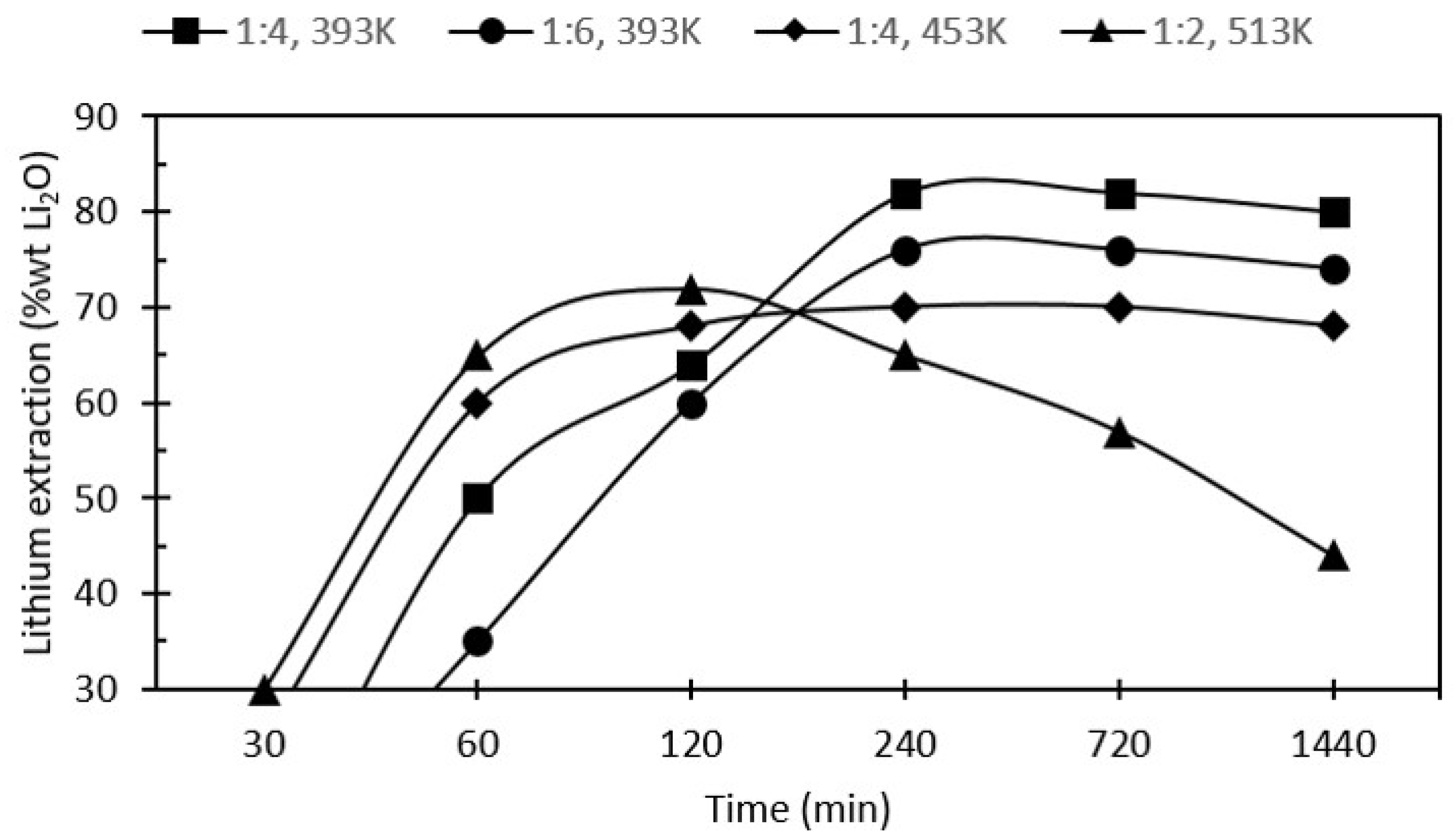
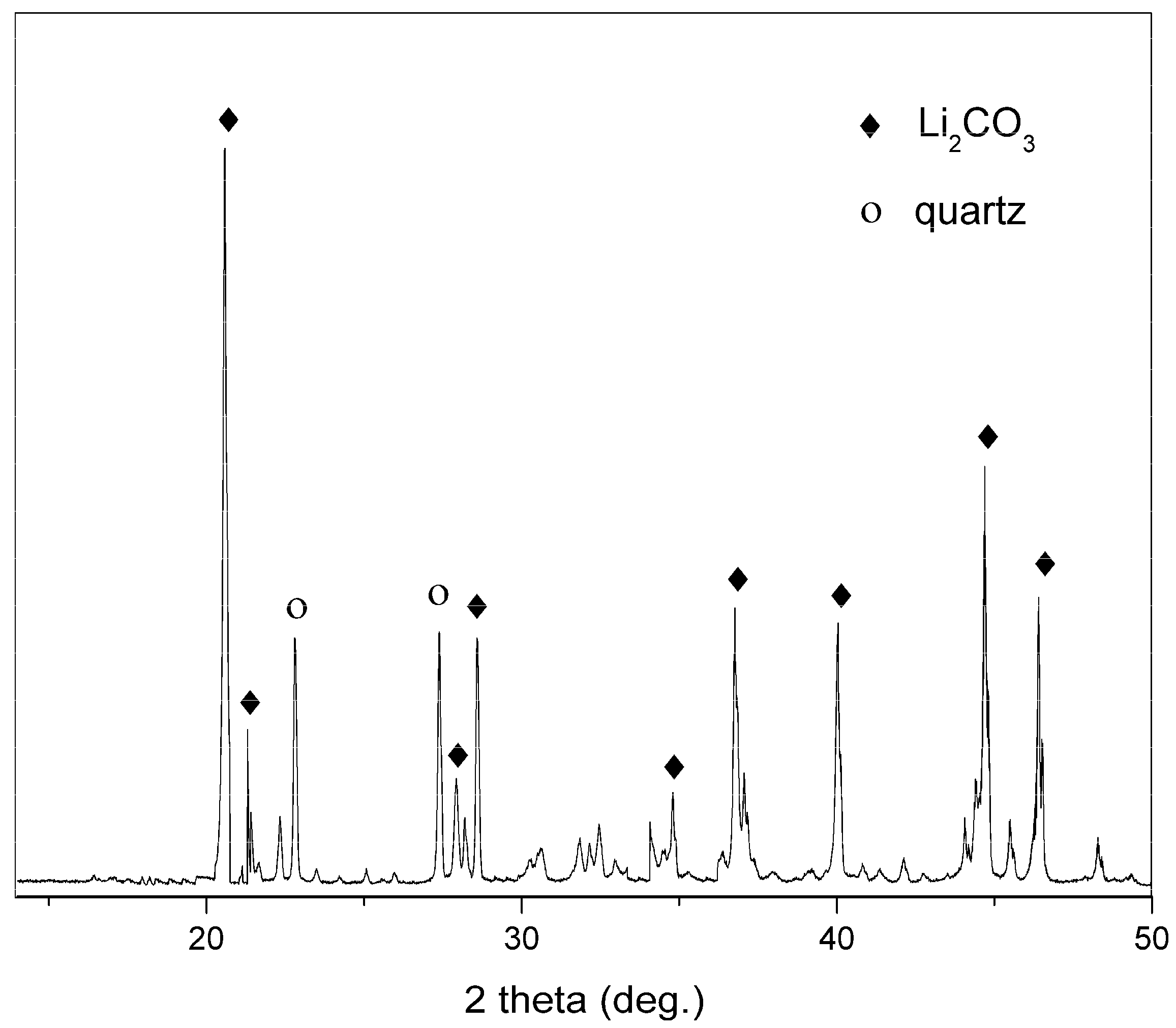
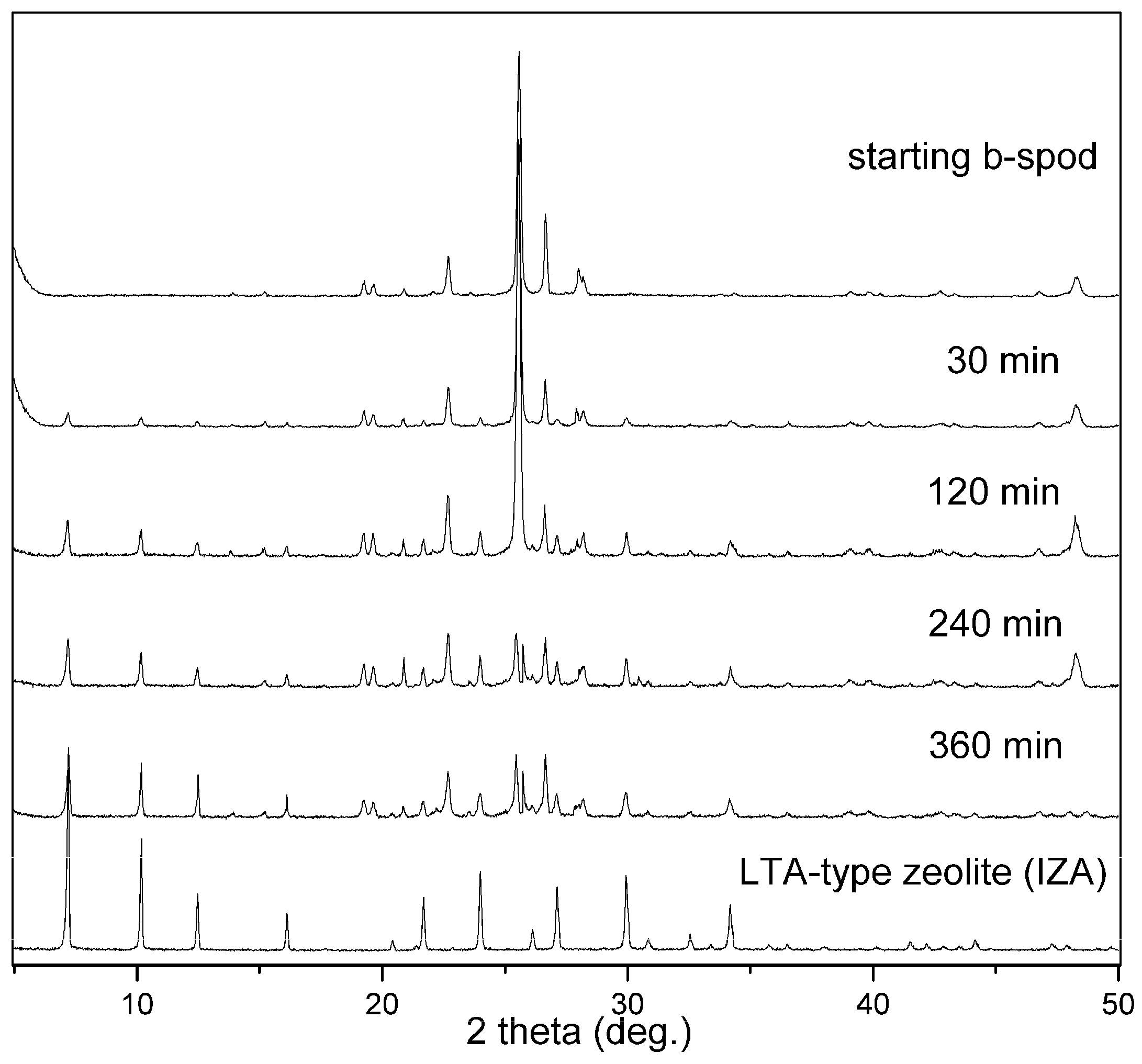


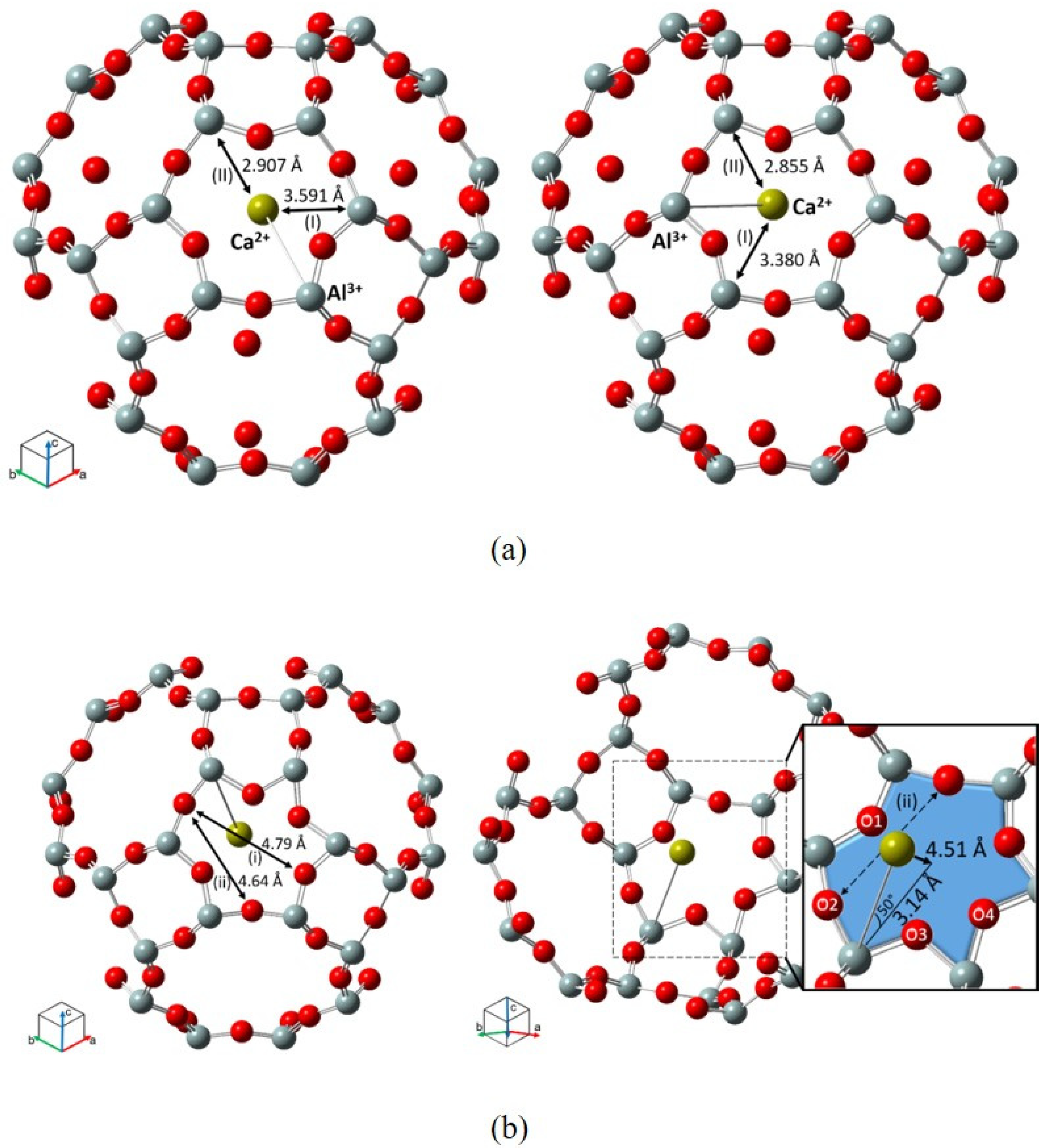
| Component | SiO2 | Al2O3 | Li2O | Fe2O3 | K2O | Others |
|---|---|---|---|---|---|---|
| Composition (%) | 68.97 | 22.31 | 6.43 | 0.92 | 0.42 | <0.40 |
| Li2CO3 Purity (%) | Content of Impurities | |||||
|---|---|---|---|---|---|---|
| Na | Si | Mg | K | Al | Others | |
| 95.4 | 1.83 | 1.12 | 0.88 | 0.53 | 0.03 | 0.21 |
Disclaimer/Publisher’s Note: The statements, opinions and data contained in all publications are solely those of the individual author(s) and contributor(s) and not of MDPI and/or the editor(s). MDPI and/or the editor(s) disclaim responsibility for any injury to people or property resulting from any ideas, methods, instructions or products referred to in the content. |
© 2025 by the authors. Licensee MDPI, Basel, Switzerland. This article is an open access article distributed under the terms and conditions of the Creative Commons Attribution (CC BY) license (https://creativecommons.org/licenses/by/4.0/).
Share and Cite
dos Santos, L.L.; do Nascimento, R.M.; Pergher, S.B.C. One-Pot Strategies for Lithium Recovery from Beta-Spodumene and LTA-Type Zeolite Synthesis. Crystals 2025, 15, 161. https://doi.org/10.3390/cryst15020161
dos Santos LL, do Nascimento RM, Pergher SBC. One-Pot Strategies for Lithium Recovery from Beta-Spodumene and LTA-Type Zeolite Synthesis. Crystals. 2025; 15(2):161. https://doi.org/10.3390/cryst15020161
Chicago/Turabian Styledos Santos, Leonardo Leandro, Rubens Maribondo do Nascimento, and Sibele Berenice Castellã Pergher. 2025. "One-Pot Strategies for Lithium Recovery from Beta-Spodumene and LTA-Type Zeolite Synthesis" Crystals 15, no. 2: 161. https://doi.org/10.3390/cryst15020161
APA Styledos Santos, L. L., do Nascimento, R. M., & Pergher, S. B. C. (2025). One-Pot Strategies for Lithium Recovery from Beta-Spodumene and LTA-Type Zeolite Synthesis. Crystals, 15(2), 161. https://doi.org/10.3390/cryst15020161








